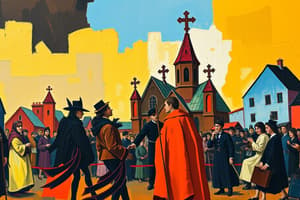Podcast
Questions and Answers
What was the primary objective of the English Puritans who sought to reform the Church of England?
What was the primary objective of the English Puritans who sought to reform the Church of England?
- To purify the Church of England by removing perceived Catholic elements and simplifying religious practices. (correct)
- To integrate Catholic practices into the Church of England to create a more inclusive religious institution.
- To establish the Church of England as the dominant religious force in continental Europe.
- To completely separate from the Church of England and establish independent congregations.
How did the Separatists, also known as Pilgrims, differ from other Puritans in their approach to the Church of England?
How did the Separatists, also known as Pilgrims, differ from other Puritans in their approach to the Church of England?
- Separatists believed in maintaining some Catholic traditions, while other Puritans wanted complete removal of Catholic influence.
- Separatists advocated for a stricter adherence to the doctrines of the Church of England, while other Puritans were more lenient.
- Separatists sought to reform the Church from within, while other Puritans aimed to establish a new church in the colonies.
- Separatists believed that the Church of England was irredeemably corrupt and advocated for complete separation, unlike other Puritans who hoped for reform. (correct)
The Mayflower Compact is significant in the context of New England colonies primarily because it:
The Mayflower Compact is significant in the context of New England colonies primarily because it:
- established peaceful relations and trade agreements with the major Native American tribes in the New England region.
- outlined a detailed economic plan for the Plymouth colony based on trade with England.
- established the Church of England as the official religion in Plymouth colony.
- demonstrated an early form of self-governance and equality under the law for white male citizens in the colonies. (correct)
What was John Winthrop's vision for the Massachusetts Bay Colony, encapsulated in his famous phrase 'city upon a hill'?
What was John Winthrop's vision for the Massachusetts Bay Colony, encapsulated in his famous phrase 'city upon a hill'?
The Fundamental Orders of Connecticut (1639) is considered historically significant for which of the following reasons?
The Fundamental Orders of Connecticut (1639) is considered historically significant for which of the following reasons?
The Halfway Covenant was adopted by New England colonies primarily in response to:
The Halfway Covenant was adopted by New England colonies primarily in response to:
Anne Hutchinson was banished from the Massachusetts Bay Colony for advocating which theological belief?
Anne Hutchinson was banished from the Massachusetts Bay Colony for advocating which theological belief?
Metacom's War, also known as King Philip's War, was primarily caused by:
Metacom's War, also known as King Philip's War, was primarily caused by:
The Navigation Acts, enacted by England, were designed to:
The Navigation Acts, enacted by England, were designed to:
William Penn founded Pennsylvania primarily to:
William Penn founded Pennsylvania primarily to:
Which of the following best describes a proprietary colony?
Which of the following best describes a proprietary colony?
Quakers were distinct from other religious groups in the American colonies due to their belief in:
Quakers were distinct from other religious groups in the American colonies due to their belief in:
Roger Williams was banished from Massachusetts Bay Colony and subsequently founded Rhode Island primarily because of his advocacy for:
Roger Williams was banished from Massachusetts Bay Colony and subsequently founded Rhode Island primarily because of his advocacy for:
The term 'Separatists' or 'Pilgrims' specifically refers to which group of people in early American colonial history?
The term 'Separatists' or 'Pilgrims' specifically refers to which group of people in early American colonial history?
Which of the following was a significant way women contributed to the American Revolution?
Which of the following was a significant way women contributed to the American Revolution?
Homespun cloth became a symbol of revolutionary sentiment in the colonies primarily because:
Homespun cloth became a symbol of revolutionary sentiment in the colonies primarily because:
Which immigrant groups constituted the largest wave of immigration to the United States between the 1820s and 1840s?
Which immigrant groups constituted the largest wave of immigration to the United States between the 1820s and 1840s?
Initially, German and Irish immigrants in the United States in the mid-19th century commonly faced:
Initially, German and Irish immigrants in the United States in the mid-19th century commonly faced:
Texas was annexed by the United States in 1845 after a period of time as:
Texas was annexed by the United States in 1845 after a period of time as:
The annexation of Texas into the United States significantly contributed to:
The annexation of Texas into the United States significantly contributed to:
Despite not owning enslaved people, most poor white Southerners in the antebellum period identified with wealthy slaveholders primarily due to:
Despite not owning enslaved people, most poor white Southerners in the antebellum period identified with wealthy slaveholders primarily due to:
The expansion of cotton cultivation in the first half of the 19th century directly led to:
The expansion of cotton cultivation in the first half of the 19th century directly led to:
Enslaved African Americans resisted slavery in various ways, which included:
Enslaved African Americans resisted slavery in various ways, which included:
The women's rights movement of the mid-1800s in the United States was significantly inspired by:
The women's rights movement of the mid-1800s in the United States was significantly inspired by:
The Declaration of Rights and Sentiments, issued at Seneca Falls, utilized constitutional language primarily to:
The Declaration of Rights and Sentiments, issued at Seneca Falls, utilized constitutional language primarily to:
In the context of the 19th-century women's rights movement, the 'private sphere' was strategically leveraged by women to:
In the context of the 19th-century women's rights movement, the 'private sphere' was strategically leveraged by women to:
Industrialization in the early 1800s led to significant changes for white Northeastern women, including:
Industrialization in the early 1800s led to significant changes for white Northeastern women, including:
The 'cult of domesticity' in the 19th century primarily promoted the idea that:
The 'cult of domesticity' in the 19th century primarily promoted the idea that:
The invention of the cotton gin had what significant impact on the demand for enslaved labor in the American South?
The invention of the cotton gin had what significant impact on the demand for enslaved labor in the American South?
How did deeply entrenched racism in the Deep South affect perceived class divisions among white people?
How did deeply entrenched racism in the Deep South affect perceived class divisions among white people?
The Southern slave economy's international reach was primarily due to:
The Southern slave economy's international reach was primarily due to:
Abolitionism as a social reform movement in the United States aimed to:
Abolitionism as a social reform movement in the United States aimed to:
The Dred Scott v. Sandford Supreme Court decision of 1857 declared that:
The Dred Scott v. Sandford Supreme Court decision of 1857 declared that:
The Lincoln-Douglas debates of 1858, while not resulting in Lincoln's immediate Senate victory, were significant because they:
The Lincoln-Douglas debates of 1858, while not resulting in Lincoln's immediate Senate victory, were significant because they:
Juneteenth commemorates what historical event in the United States?
Juneteenth commemorates what historical event in the United States?
Black Codes, enacted by Southern states after the Civil War, were primarily intended to:
Black Codes, enacted by Southern states after the Civil War, were primarily intended to:
The Ku Klux Klan, emerging during Reconstruction, sought to undermine the Republican party and enforce white supremacy through:
The Ku Klux Klan, emerging during Reconstruction, sought to undermine the Republican party and enforce white supremacy through:
Congress responded to the violence and intimidation tactics of the Ku Klux Klan by passing:
Congress responded to the violence and intimidation tactics of the Ku Klux Klan by passing:
The Freedmen's Bureau, established in 1865, was created to:
The Freedmen's Bureau, established in 1865, was created to:
Social Darwinism, as applied in the Gilded Age, promoted the idea that:
Social Darwinism, as applied in the Gilded Age, promoted the idea that:
Urbanization in the late 19th and early 20th centuries in the United States was primarily driven by:
Urbanization in the late 19th and early 20th centuries in the United States was primarily driven by:
The Populist movement of the late 19th century primarily aimed to:
The Populist movement of the late 19th century primarily aimed to:
The People's Party, formed in 1891, emerged from which preceding movements?
The People's Party, formed in 1891, emerged from which preceding movements?
Flashcards
Puritans
Puritans
English Protestants seeking to purify the Church of England from Catholic influences.
Fundamental Orders of Connecticut (1639)
Fundamental Orders of Connecticut (1639)
A document establishing a representative government in Connecticut with a legislature elected by popular vote.
Halfway Covenant
Halfway Covenant
A religious compromise allowing partial church membership in New England without a conversion experience.
Anne Hutchinson
Anne Hutchinson
Signup and view all the flashcards
Metacom’s War
Metacom’s War
Signup and view all the flashcards
Navigation Acts
Navigation Acts
Signup and view all the flashcards
William Penn
William Penn
Signup and view all the flashcards
Proprietary colony
Proprietary colony
Signup and view all the flashcards
Quakers
Quakers
Signup and view all the flashcards
Roger Williams
Roger Williams
Signup and view all the flashcards
Separatists / Pilgrims
Separatists / Pilgrims
Signup and view all the flashcards
John Winthrop
John Winthrop
Signup and view all the flashcards
Homespun
Homespun
Signup and view all the flashcards
Germans and Irish
Germans and Irish
Signup and view all the flashcards
Texas Annexation
Texas Annexation
Signup and view all the flashcards
Social Darwinism
Social Darwinism
Signup and view all the flashcards
Populist Movement
Populist Movement
Signup and view all the flashcards
Black Codes
Black Codes
Signup and view all the flashcards
Ku Klux Klan
Ku Klux Klan
Signup and view all the flashcards
Freedmen’s Bureau
Freedmen’s Bureau
Signup and view all the flashcards
Juneteenth
Juneteenth
Signup and view all the flashcards
Declaration of Rights and Sentiments
Declaration of Rights and Sentiments
Signup and view all the flashcards
Abolitionism
Abolitionism
Signup and view all the flashcards
Study Notes
- Puritans were English Protestants aiming to "purify" the Church of England by removing Catholic elements from religious practices.
- English Puritans established Plymouth Colony to freely practice their Protestantism.
- New England society had equality under law for white men, a strong work ethic, and a maritime economy.
- After the "pilgrims" in 1620, more English Puritans came to New England.
- They founded the Massachusetts Bay Colony, New Haven Colony, and Rhode Island.
- These Puritans aimed to be a "city upon a hill" to reform Protestantism in the English Empire.
Key Terms
- Fundamental Orders of Connecticut (1639): Established a representative government in Connecticut with a popularly elected legislature and a governor elected by the legislature.
- Halfway Covenant: Allowed New England colonists to become partial church members without a conversion experience.
- Anne Hutchinson: Banished from Massachusetts Bay Colony for believing salvation was based on faith, not deeds; founded Portsmouth colony in 1638, which became part of Rhode Island in 1663.
- Metacom’s War (1675-1676): Also known as King Philip's War, Wampanoag and Narragansett tribes fought English expansion; English won, ending most Native American resistance in New England.
- Navigation Acts: Acts from 1650-1673 regulating colonial trade: only English ships, goods had to pass through English ports, and specific goods could only be exported to England.
- William Penn: Founded Pennsylvania in 1681 as a safe haven for Quakers.
- Proprietary colony: Colonies under the authority of individuals with charters of ownership, such as Maryland and Pennsylvania.
- Puritans: Protestants wanting to purify the Church of England; some moved to Massachusetts Bay Colony to escape religious persecution.
- Quakers: Believed in nonviolence, gender equality, and resistance to military service; many lived in Pennsylvania.
- Roger Williams: Founded Providence in 1636 after being expelled from Massachusetts Bay Colony for criticizing Puritanism; Providence became part of Rhode Island in 1663.
- Separatists/Pilgrims: Puritans who wanted to separate from the Church of England.
- John Winthrop: A leading figure in founding the Massachusetts Bay Colony.
Motivations and Environment
- Main motivations for colonizing New England and the Middle Colonies and the effect of the environment on their economies.
- Comparison of English interactions with Native Americans to Spanish interactions.
Women's Role in the American Revolution
- Women supported the war effort by organizing fundraising, supplying troops, and tending to wounded soldiers.
- Making homespun cloth became a revolutionary symbol after boycotts on British textiles.
- Some women acted as spies, and one instance of a woman disguising as a man to fight in the war.
Immigration in the 1820s-1840s
- Germans and Irish were the largest immigrant groups to the US.
- They faced anti-foreign prejudice and discrimination.
- Eventually, they assimilated into US culture and became successful immigrant groups.
Annexation of Texas
- Texas was annexed by the US in 1845, becoming the 28th state.
- Until 1836, Texas was part of Mexico.
- Settlers from the US declared independence in 1836, forming the Republic of Texas for nine years.
- US politics were divided over admitting Texas as a slave or free state; it was admitted as a slave state.
- The annexation contributed to the Mexican-American War (1846-1848), partly due to a border dispute.
Slavery and Southern Society
- Three-quarters of the white population in the South did not own enslaved people.
- White supremacy led poor whites to identify with rich slaveholders over enslaved African Americans.
- Southern writers defended slavery as a "positive good," falsely portraying happy enslaved people.
Cotton and Expansion of Slavery
- Demand for cotton in the early 19th century expanded plantation slavery.
- By 1850, enslaved people grew cotton from South Carolina to Texas.
African Americans in the 19th Century
- Most African Americans were enslaved, working on farms in the South and West.
- Enslaved people resisted slavery through defiance and uprisings, despite lacking basic rights.
- Free people of color lived in Northern cities and the Upper South, playing a key role in the abolition movement.
Women's Rights Movement
- The women’s rights movement gained traction through abolitionism and the Second Great Awakening.
- The Declaration of Rights and Sentiments (1848) highlighted inconsistencies between national commitments to equality and the treatment of women.
- Leveraged their roles in the private sphere to organize and empower white women.
Industrialization and Changing Roles
- Industrialization in the early 1800s drew white Northeastern women into factories and schoolhouses, such as the Lowell Mills.
- Some women professionalized homemaking as part of the cult of domesticity.
- While, African American women in the South remained enslaved. Also, Native American women faced precarious conditions due to Indian Removal and Manifest Destiny.
Cotton Gin and Economic Impact
- The cotton gin made cotton the main crop of the Deep South, increasing demand for enslaved people.
- Class divides widened between plantation owners and poor whites in the Deep South, but entrenched racism blurred these divides.
- The Southern slave economy was internationally connected through cotton exports.
Abolitionism
- Abolitionism sought to abolish slavery in the US from the mid-18th century to 1865.
- Evolved from religious roots to political action, sometimes violent.
- Key members were African American men and women who escaped slavery.
- The 1857 Dred Scott decision denied Black people US citizenship, heightening tensions between North and South.
- The Dred Scott case became a central issue in the Lincoln-Douglas Senate race.
- The Lincoln-Douglas debates put Abraham Lincoln in the national spotlight, leading to his 1860 presidential nomination.
Juneteenth
- On June 19, 1865, the last enslaved people learned of the Emancipation Proclamation.
- Juneteenth commemorates this event and celebrates Black history and freedom.
- US Congress made Juneteenth a federal holiday in 2021.
Black Codes
- Southern states created black codes after slavery was abolished to maintain white supremacy.
- Black codes aimed to economically disable freed slaves.
- Black codes resulted in a new wave of radical Republicanism and pushed for racial equality in the Constitution.
- Black codes set the stage for Jim Crow laws.
Ku Klux Klan
- The Ku Klux Klan emerged during Reconstruction as a white supremacist terrorist group.
- The Klan used violence/intimidation to undermine the Republican party.
- Congress countered with the Force Acts and the Ku Klux Klan Act of 1871, which outlawed Klan violence.
- Klan violence led to Republicans losing power in the South, enabling Jim Crow laws.
Freedmen’s Bureau
- The Freedmen’s Bureau was established in March 1865 to help freed people secure economic stability and political freedoms.
- Many white Southerners and President Andrew Johnson challenged the Bureau’s legitimacy.
- The Bureau raised questions about the federal government's role in ensuring racial and economic equality.
Social Darwinism
- Social Darwinism misapplied Charles Darwin's evolutionary language to politics, the economy, and society.
- Social Darwinists supported laissez-faire capitalism and racism.
- They believed that government should not interfere with "survival of the fittest" and promoted racial superiority.
- Social Darwinism influenced American society during the Gilded Age, affecting immigration, imperialism, and public health policies.
Urbanization
- Americans moved into cities in the late 19th and early 20th centuries due to industrialization.
- From 1870 to 1920, 11 million people migrated from rural to urban areas, with most of the 25 million immigrants moving into cities.
- By 1920, more Americans lived in cities than in rural areas.
Populist Movement
- The Populists were an agrarian-based political movement aimed at improving conditions for farmers and agrarian workers.
- Preceded by the Farmer’s Alliance and the Grange.
- The People’s Party, founded in 1891, was driven by leaders of the Populist movement.
- They allied with labor and were folded into the Democratic Party in 1896.
- A small remnant of the People’s Party existed until 1908.
Studying That Suits You
Use AI to generate personalized quizzes and flashcards to suit your learning preferences.




